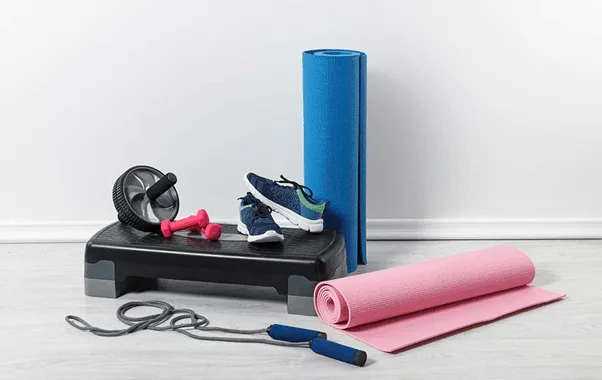
I’ve struggled with adopting new healthy habits for life, and you’ve probably struggled, too.
I used to start with big, ambitious plans and goals. Think big or go home, right?
I would go to the gym for intense workouts, or stop eating sweet treats for a while. Only to go back to my previous habits within a few weeks (ok, sometimes within a few days!).
There must be something specific we can do about it, right? We all want to build healthy habits for life.
Table of Contents
Building New Healhy Habits That Stick
Well, I have learned a thing or two about building & keeping new healthy habits, and learned I was doing it all wrong. What has worked for me has been building moderate, but consistent new habits. I try to work on one new healthy habit until it truly becomes a habit and I hardly have to think about it anymore. Then, I move on to another habit. And I’ve become much better at building new healthy habits for life: over the last few years, I’ve improved my strength, weight, and nutrition through small changes at a time.
Top 20 Healthy Habits For Life
These 20 healthy habits are no-brainers. They require little effort and come with big rewards. We’ve selected these 20 habits because they are easy to start and keep for life, and have a high positive impact on your body & mind.

We’ve broken down these 20 habits into 3 main buckets: 1) Healthy food habits, 2) Healthy fitness habits, and 3) Healthy minds habits:
Healthy Food Habits to Build For Life:
1. Put Healthy Food Front & Center in Your Kitchen
2. Drink Water Before Each Meal
3. Include a Fruit or Veggie With Each Meal: Start adding at least 1 serving of fruit or veggies, with each meal (no exception). For example: at breakfast, scrambled eggs with toast and a large apple.
4. Plan Your Meals Ahead of Time: Planning your meals for the week helps make sure you are in control of what you eat, and that you don’t end up just ordering take-out or picking naugthy food out of the fridge.
5. Kickstart your Day with a Healthy Breakfast. Starting with a breakfast that’s good for you is a fantastic new healthy habit to start. It kicks your day off on the right note.
Healthy Fitness Habits to Build For Life:
Research shows (Source) that staying active and exercising regularly has the following benefits: 1) Better sleep, 2) Increased sexual interest, 3) Less stress, 4) Improvement in mood, and 5) Increased energy, 6) Weight loss. Sounds good? Let’s get started with the best habits to stay active:
6. Go for a Daily Walk. According to the Mayo Clinic, we need 30 minutes per day of moderate physical activity daily, such as walking.
7. Establish a Simple Daily Exercise Routine (5 minutes). Even small amounts of exercise can profoundly impact our energy levels, well-being, and productivity.
8. Stretch For Two Minutes When Getting Up. Stretching for 2 minutes in the morning can help loosen you up, make you more nimble and gradually improve your range of motion.
9. Track your Steps Automatically. Tracking your steps automatically is a fantastic healthy habit to start. It’s easy and can do wonders to hold you accountable AND motivated to stay active.
10. Get your Muscles a Good Work-out. Exercises such as weight lifting or push-ups twice a week can help you lose weight, gain muscle mass, strengthen your bones, while making you look and feel better.
11. Take The Stairs When Possible. Going up a flight of stairs isn’t that challenging and is a great healthy habit to keep for life.
Healthy Habits for a Happy Mind:
12. Spend 2 hours per week in nature. A new study shows that you should spend at least 2 hours per week in nature: the results from this new study, involving 20,000 participants, were published in the scientific magazine Nature.
13. Being Mindful or Meditating 5 minutes per day. Studies have shown that being mindful can reduce stress and improve your mood. There is even early evidence that mindfulness can help reduce depression with certain patients to some extent (Source: Harvard Health & Medicine).
14. Go to Bed Half An Hour Earlier. You’ve probably heard that sleep is essential to your health and happiness. Good sleeping habits should at at the top of your list of new healthy habits to start if you have trouble sleeping.
15. Keep a Journal / Practise Gratitude. Harvard Health wrote that “most of the studies published on (gratitude and happiness) support an association between gratitude and an individual’s well-being”.
16. Get Up As Soon As Your Alarm Goes Off. Once you are up, start off your day on a positive note. Take 2 minutes to stretch or drink a glass of water. This means that you will turn unproductive time (browsing through Facebook in bed) into a new healthy and positive habit.
17. Prepare Some Things The Night Before. Many people feel overwhelmed in the morning because they leave everything for when they wake up.
18. Read A few Pages Before Bed. Reading ten pages before bed might not seem like much. But look at the impact over an entire year: Ten pages per night would net you over 3,600 pages in a year, or around 10-12 average books.
19. Learn to Disconnect From Your Phone. Using your smartphone too much can be detrimental to your focus, productivity, and general well-being.
20. Laugh Today… And Every Day. The Mayo Clinic states that “When it comes to relieving stress, more giggles and guffaws are just what the doctor ordered”. Laughing doesn’t just improve your mood, it also changes your body physically.
Learn more about these habits to start today.
I hope this list helped you find a few new habits that you want to build in your own life. Having a list of healthy habits to build for life is great for inspiration, but how do you make sure that you start these habits and keep them for life? Read my top 6 tips below to build habits for life.
My 6 Tips to Build Healthy Habits For Life
Below are my six favorite tactics you can use to build habits that stick for life. These tactics truly make it so much easier to adopt and keep your new habits:
So let’s go:
1. Change Your Home to Make Your New Habits Very Visible

You might be surprised to learn that we often make choices in our daily lives simply based on their accessibility. For example, if you buy a box of cookies and leave it on the kitchen table, you are pretty much guaranteed to snack on them pretty quickly, right?
The great news is that it works the other way around: if you make these foods less accessible and instead fill your home with whole and nutritious foods, you are a lot more likely to start eating those! By placing healthy options front and center, research shows that you might increase your consumption of healthy options by as much as 25% (Source: MA General Hospital study).
And it will be sooooo much easier for you to build consistent new healthy habits if your home is designed to promote these new healthy choices.
Keep your home full of healthy options: a bowl of fruit on the kitchen table, oatmeal in the pantry, and healthy foods positioned front and center in your fridge. I like to have plenty of baby carrots and hummus in my fridge because I can easily snack on them (and avoid other had choices).
This applies to other aspects of health and self-improvement, too:
- If you want to read more, have a book on your nightstand
- If you want to watch less TV before bed, get the television out of your bedroom
- If you want to exercise at home, clear some space and lay out your fitness equipment
- If you want to drink more water, leave a few bottles in key places where you’re likely to see them often
The point is that changing your home to make your new habit more visible will make it easier to keep your new habits for life.

2. Change Your Home to Avoid Poor Choices and Temptations
It’s just too hard to resist temptations. So try to minimize how often these temptations occur.
Just like you want to promote new healthy habits and choices, you want to make it just a little harder to make poor choices. We should do what we can to avoid dealing with temptations and bad habits.
The name of the game is this: try to minimize temptations as much as possible. We human beings are just not good at dealing with temptations. Forcing ourselves to resist temptations simply doesn’t work for a long time because willpower only lasts for so long. Sure, we can fight it for a few hours, days, or weeks. But eventually, we will give in. We will eat a few cookies if the cookie jar is on our countertop.
People with seemingly superior self-control aren’t necessarily more disciplined. They might just have organized their lives better. In other words, they might not put themselves in situations that test their willpower as much.

For example, if you struggle with a specific trigger food, make it difficult to access. Stash it away where you don’t get to see it all the time or place it somewhere difficult to reach. If that doesn’t work, don’t buy that food in the first place.
More often than not, these extra hurdles are enough to prevent you from making poor choices.
3. Pick New Habits You Actually Enjoy & You Will Keep Them Going For Life
I used to think that health and fitness are dull but necessary aspects of life. Yep, that’s it, you need to suffer and go to the gym regularly if you want to be fit. Or you have to eat these awful vegetables if you want to be healthy.
The truth is, we need to find a routine and habits that we enjoy. Enjoying your new habit is a cornerstone of consistency and long-term results.
For example, you’ve probably come across statements like, “Do this training program to burn fat and get healthy.” A lot of people believe that these programs need to become an essential part of their journey, regardless of how it makes them feel. They accept the pain as part of the deal.
But ask yourself this:
If you don’t enjoy the process, how likely are you to stick with it? How well can you motivate yourself over and over again? Sure, you can do it for a bit, but once the excitement of the novelty wears off, you will give up. So find habits that you enjoy. Perhaps it’s a jog in the park with a friend. Or making sure that you have a full bowl of these apples that you love on your kitchen countertop.
Eating for weight loss is rarely a pleasurable feeling, but you can make it sustainable through sound tactics revolving around calorie tracking and flexible eating choices. You shouldn’t feel like your nutrition is prison.
The same goes for fitness. You should look forward to your upcoming workout. If you dread it, you’re doing something wrong.
4. Track How Well You Are Doing – it is Super Motivating
I love tracking my performance and seeing improvements. It keeps me going, maintains my motivation, and pushes me to do even more. Seeing progress is fantastic because it creates a positive feedback loop:
Work leads to results, which motivate us and push us to do even more work that delivers even more outstanding results.
It also holds me accountable: my app or my habit trackers don’t lie. I can immediately see if I haven’t done my workouts as I planned.
You can use different tools to track your progress. What matters most is that you monitor your habits and stay consistent. In doing so, the data has more value and accuracy.
A great way to go about it is to make progress tracking automatic. For example, if you want to become more active and walk more each day, a great way to get started is to install a step-tracking app on your phone. Once installed, it tracks your activity and gives you actionable data every hour of the day. It’s easy because you don’t have to do anything. All you need to do is check it regularly, set actionable goals for each week, and go about your day.
Another thing you can do is track your consistency through a calendar, journal, or phone application. The goal is to log your work before or after completing it and make sure to do so each day.
Famous comedian Jerry Seinfeld used this strategy of never missing twice in a row. His goal was to write jokes every day, and he would have this rule of never missing twice in a row. In other words, if he didn’t write jokes one day, he would absolutely write the day after. In doing so, he never allowed himself to break the chain of consistency.
5. Share Your Healthy Habit with a Friend
One of the best ways to develop and stick with better habits is to make friends who share similar goals. The truth is, we are social creatures, and we tend to mimic the behaviors and habits of the people we surround ourselves with.
An interesting study illustrates this perfectly: The study observed more than 12,000 people for over thirty years. Researchers stated, “A person’s chances of becoming obese increased by 57% if he or she had a friend who became obese in a given interval. Among pairs of adult siblings, if one sibling became obese, the chance that the other would become obese increased by 40%. If one spouse became obese, the likelihood that the other spouse would become obese increased by 37%.”
For example, if you want to take up jogging, develop a friendship with a person who does this regularly. That way, you can keep each other accountable, stay motivated, and improve together. Alternatively, you can join groups where your desired actions or outcomes are the norm.
We need to surround ourselves with like-minded individuals who push us toward our desired actions that shape our desired outcomes. The question is, how? One way I’ve outlined in my article (4 ways to keep in touch with friends and family when you’re in lockdown – The (mostly) Simple Life) is to join a fitness class together.
6. Stack Your Habits
Whether you realize it or not, many of the things you do each day follow a trigger or cue. For example, if your phone buzzes (trigger), you pick it up and check the notification (habit).
This can be good and bad, depending on the context. For example, if a trigger leads to unhealthy behavior, that’s not good. Luckily, we can leverage our psychology to establish healthy habits for life.
Habit stacking is the act of bundling together different behaviors. For example, after a given action, you do something else.
“After getting back home, I will put on my workout clothes.”
In this example, going back home is the trigger, and putting your workout clothes on is the habit. You can also stack putting your workout clothes on with a warm-up routine for your workout. It would look like this:
Get back home -> Put workout clothes on -> Start warming up -> Exercise for half an hour
In this case, you would be using things you’re already doing as a trigger for other positive behaviors.
If you’re already good at doing something, use it as a trigger to follow up with another positive behavior in a similar category. For example, if you tend to make your bed as you wake up each morning, use it as a trigger to follow up with five minutes of meditation.
So… there you have it. I hope these strategies work for you. I know it’s a lot to digest, but get started in a small way. Pick one or two strategies that can help build great new healhy habits.
Here are the 6 strategies in summary to help build new healthy habits for life:
1. Design Your Home to Make Your New Healthy Habits Very Visible
2. Design Your Home to Avoid Poor Choices
3. Pick New Habits You Actually Enjoy
4. Track How Well You Are Doing!
5. Share the Healthy Habit with a Friend
6. Stack Your Habits
Related Posts:
Learn more about building healthy habits for a happier life or learn the 3 best ways to kick-start a new healthy habit.



